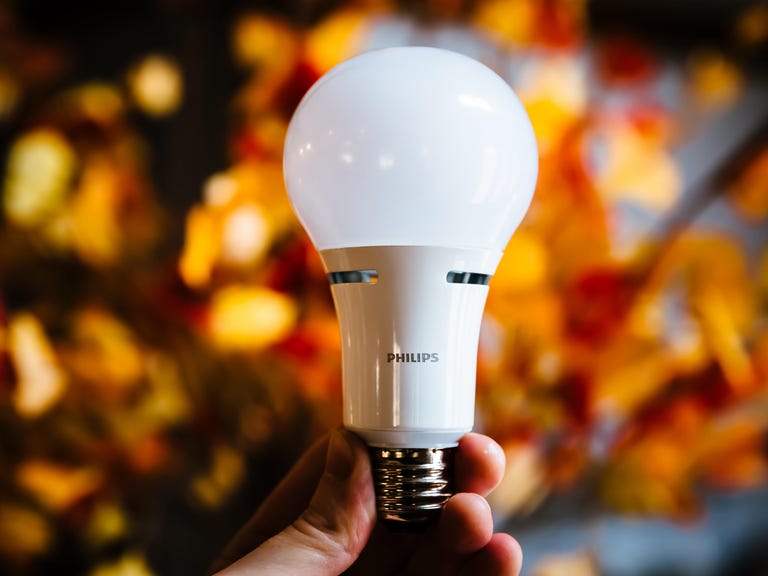 Why You Can Trust CNET
Why You Can Trust CNET Philips 100W Replacement Warm Glow LED review: Like orangey, dimmable light? Then you'll love this LED
Dim the Philips 100W Replacement Warm Glow LED and watch its color temperature shift from yellow to orange like a dying flame. Technology!
Philips makes a number of "Warm Glow" LEDs that shift from yellowy light to something more orange and flame-like as you dim them down. I appreciated the feature when I tested out the 60-watt replacement, vintage-style version with fake filaments, so testing out the bigger, brighter 100-watt replacement version, which you'll find at Home Depot for about $13 per bulb, seemed like a logical next step.
The Good
The Bad
The Bottom Line
Like the wattage equivalency suggests, the 100-watt version of the Warm Glow LED puts out just over 1,600 lumens' worth of brightness, and it does so using a power draw of 18 watts, making it good for 89.2 lumens per watt. That's good enough to knock some money off of your power bill each month, but it isn't quite as efficient as the competition. 18 watts was a higher draw than any other bulb I tested, and the lumens-per-watt ratio was the lowest of any of the ones I tested that dim.
Still, the difference in operating cost between this bulb and the most efficient one I tested, the Utilitech 100W Replacement LED , is a little under 50 cents per year, so we're splitting hairs to some extent.
All LEDs will lose some of their initial brightness as things heat up inside of the bulb. The Warm Glow LED lost less than 2 percent, which is an excellent result.
On the plus side, the Warm Glow LED did manage to finish tied for the top spot in my heat-management tests, where I track how heat build-up in an enclosed environment affects the performance of the bulb. Like most electronics, LED bulbs will see a performance dip as things heat up, with brightness typically falling by anywhere from 5 to 15 percent in the first 90 minutes of use. With the Warm Glow LED, that number was less than 2 percent, an outstanding result that's indicative of a well-built bulb.
The Warm Glow LED emits, well, a warm glow that shines evenly in all directions. Dim it down, and the light will grow slightly more orange and candlelike in tone.
That might also indicate that the Warm Glow LED would hold its own in an enclosed fixture, where heat gets trapped, but please note that Philips advises against using the bulb in settings like that. (With two exceptions, so did all of the 100-watt replacement LEDs I tested.)
The real question with this bulb is whether or not the bulb dims well. The candelabra-style Warm Glow LED I tested last year flickered a little too much on dimmer switches, undercutting its Warm Glow appeal. Fortunately, that wasn't the case this time around. The 100-watt version didn't flicker one bit, and it dimmed down to a satisfying average minimum of 7 percent across all of the switches I tested it with. I did notice a slight hum as I dimmed it to the medium setting on an old-school rotary dial designed for incandescents -- for switches like those, I'd recommend going with the Cree 100W Replacement LED, instead.
Still, for what it's worth, you won't get that Warm Glow effect with the Cree LED or with any other non-Philips LED, for that matter. It works as advertised -- though, to my eye, the bulb looks a little orangey to start with, making for a Warm Glow effect that's more subtle than you might desire.
All in all, this is a perfectly good light bulb, but the price gives me pause. Thirteen dollars is a lot less than what you'd have paid a few years ago, but it's still more than twice what you'll spend on some surprisingly strong competitors from names like Utilitech and EcoSmart. Philips justifies the extra expense with its unique approach to dimming, and also with the fact that it promises to last longer than any other 100-watt replacement LED I tested (22.8 years, with a 5-year warranty, to be specific), and there's some merit there. Still, I think I'd really have to want that Warm Glow dimming in order to pull the trigger.
For more on bulbs like this one, be sure to check out our overview of the best 100-watt replacement LEDs, which we'll update regularly as new reviews come in.
Watts vs. lumens: How to choose the right LED light bulb.
Smart home product compatibility: Choose a platform to see what products work with it.


